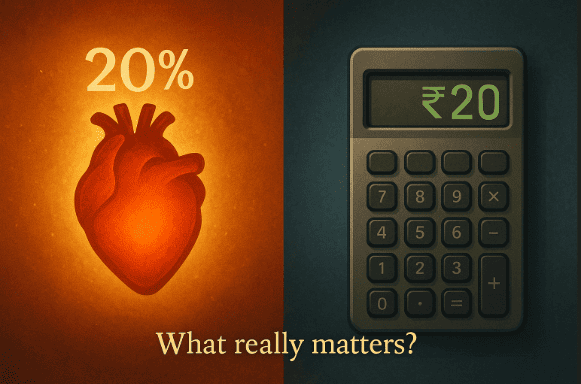
The Misleading Simplicity of Numbers
In science, measurement is sacred. Defined units. Calibrated tools. Standard conditions.
Length is measured in meters. Time in seconds. Weight in kilograms. No arguments, no confusion.
But step into real life… and we abandon all that.
We start measuring love with the number of texts, worth with rupees, and effort with hours — but never ask: What are those numbers really made of?
It’s like trying to measure a forest’s beauty with a ruler.
The ₹2 That Was Worth More Than ₹20
Let me tell you a story.
You’re standing at a tea stall with two friends. You forgot your wallet. One friend gives you ₹2. Another gives ₹20.
Seems obvious who was more generous, right?
But look closer.
-
The one who gave ₹2 only had ₹10 in total.
-
The one who gave ₹20 had ₹1,00,000 in their account.
Now who gave more?
The first gave you 20% of everything they had.
The second gave 0.002% of their fortune.
Who felt it more? Who meant it more?
Suddenly, the story flips.
We realize: true value isn’t in what’s given, but in what it cost to give.
The Illusion of Time
Now let’s talk about love.
A girl has two boys to choose from.
On paper, it’s clear:
Vijay gives her 2-3 hours of attention daily, calls, texts, video chats.
Varun gives her just 30 minutes to an hour.
Easy choice, right?
But again, look deeper.
-
Vijay is jobless. He watches web series all day. He has 14+ free hours daily. Giving 2-3 hours? That’s just 15-20% of his free time.
-
Varun works a 9–5 job. Then grinds on a side hustle for 5 more hours. After everything, he has maybe 1-2 free hours left.
Yet, he still gives her half or more of it, every single day.
Now who’s really giving more?
Who is choosing her against all odds, and not just out of boredom?
Measure in Percent, Not in Naked Numbers
We’ve been using the wrong ruler.
We measure money without context.
We measure time without asking what was sacrificed.
We judge people by how much they give, instead of how much it cost them to give it.
The truth?
“A better way to measure life is in percentages, not in naked numbers.”
Let every gift, every gesture, every second… be measured against the whole it came from.
That’s the only way to know its true value.
A Call to See Clearly
Imagine if we started seeing life like this.
-
Appreciating the friend who shows up even when they’re exhausted.
-
Valuing the partner who makes time, even if it’s just ten minutes of presence.
-
Respecting the ₹2 someone gave, knowing it was all they had.
That’s how we stop judging generosity by the size of the fruit,and start seeing the size of the tree it came from.
Let’s stop letting numbers lie to us.
Let’s measure like wise humans, not blind calculators.
Last Words:
The most meaningful things in life often come in small packages, not because they are little, but because they came from someone who gave from their everything.
Next time you measure… ask not “how much?”, but “how much of what?”
That’s where the truth lives.
